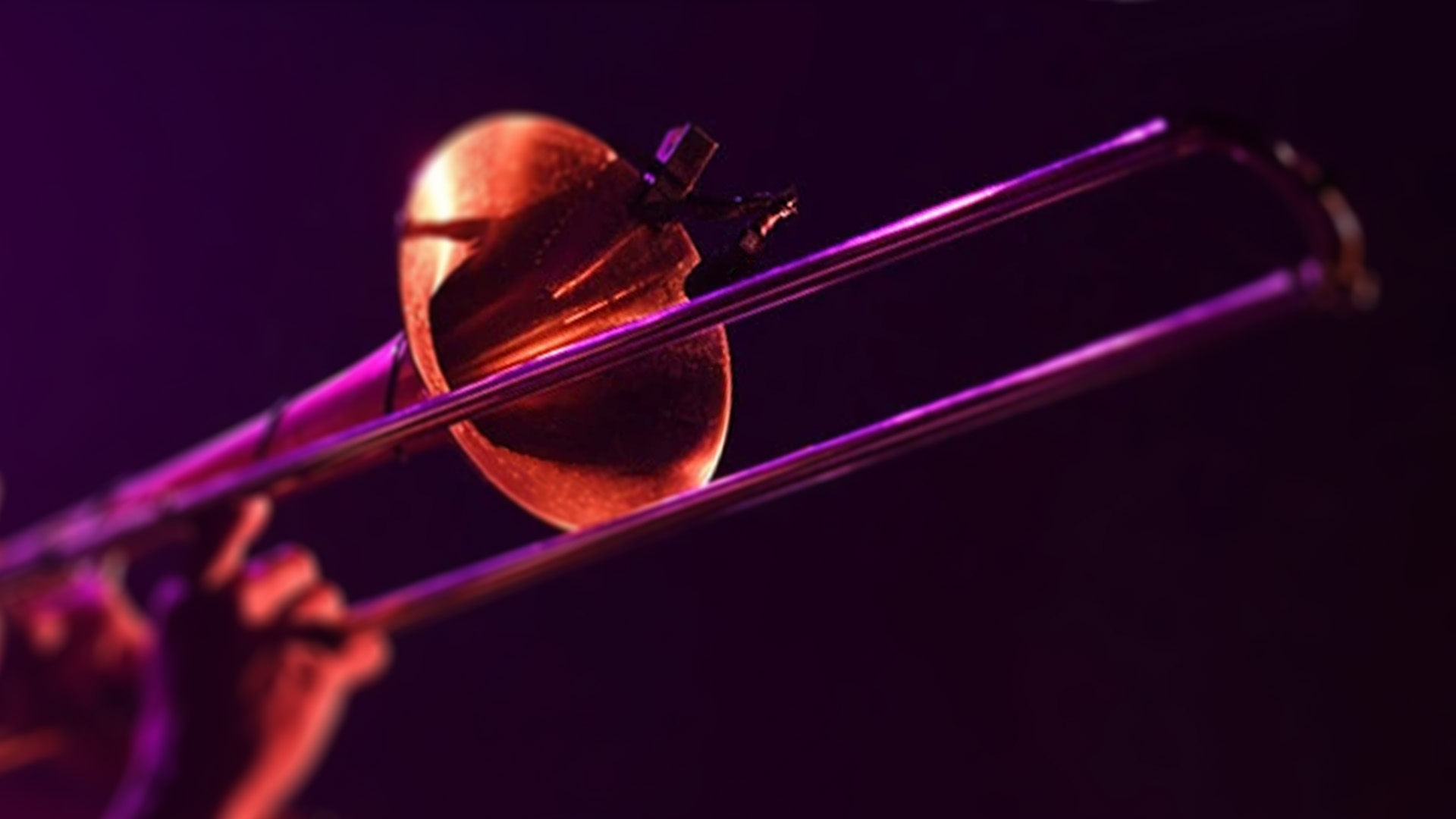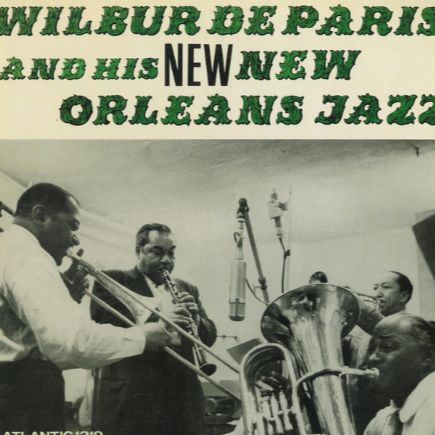Wilbur De Paris: revitaliser le jazz de la Nouvelle-Orléans
Tromboniste, compositeur et chef d’orchestre américain, Wilbur De Paris occupe une place singulière dans l’histoire du jazz pour avoir su conjuguer l’esprit festif du dixieland avec l’élégance rythmique du swing. S’inspirant des arrangements élaborés des Red Hot Peppers de Jelly Roll Morton, il développe un langage musical à la fois ancré dans la tradition et résolument tourné vers la modernité.
Issu d’un milieu musical foisonnant, Wilbur De Paris se forge dès les années 1920 une solide réputation aux côtés de figures majeures comme Louis Armstrong, Duke Ellington et Cab Calloway. Son jeu de trombone, à la fois robuste, expressif et nuancé, se distingue par sa capacité à s’intégrer dans les dynamiques collectives du jazz de la Nouvelle-Orléans tout en y apportant une touche de raffinement empruntée au swing et au blues.
S’il est parfois associé à son frère, le trompettiste Sidney De Paris, c’est en tant que leader de l’ensemble Wilbur De Paris and His New New Orleans Jazz Band qu’il inscrit son nom dans la mémoire du jazz. Son parcours l’amène à jouer avec les orchestres de Noble Sissle et Teddy Hill, à enregistrer avec le Mills Blue Rhythm Band, puis à retrouver Louis Armstrong, avec qui il collabore à nouveau entre 1937 et la fin de la décennie. Au cours des années 1940, il se produit notamment aux côtés d’Ella Fitzgerald et de Roy Eldridge, et joue avec l’orchestre de Duke Ellington entre 1945 et 1947.
C’est pourtant dans les années 1950 que Wilbur De Paris affirme pleinement sa vision artistique. Tandis que le bebop et le cool jazz s’imposent, il réaffirme l’importance du jazz traditionnel en proposant une relecture inventive qu’il nomme New New Orleans Jazz. Cette approche conjugue l’improvisation collective propre au style early, l’élan festif du répertoire de La Nouvelle-Orléans et la rigueur rythmique du swing. Son orchestre connaît alors un succès notable, en particulier avec les albums Rampart Street Parade (1952) et Marchin’ and Swingin’ (1956), véritables concentrés d’énergie et de sophistication.
En concert, l’ensemble séduit un large public, aux États-Unis comme en Europe, où la redécouverte du jazz classique suscite un fort engouement. Par son sens de l’arrangement, son engagement scénique et sa capacité à faire revivre une tradition tout en la renouvelant, Wilbur De Paris s’impose comme un passeur essentiel entre les âges du jazz.
Wilbur De Paris: revitalizar el jazz de Nueva Orleans
Trombonista, compositor y director de orquesta estadounidense, Wilbur De Paris ocupa un lugar singular en la historia del jazz por haber sabido combinar el espíritu festivo del dixieland con la elegancia rítmica del swing. Inspirado en los arreglos elaborados de los Red Hot Peppers de Jelly Roll Morton, desarrolló un lenguaje musical arraigado en la tradición pero orientado decididamente hacia la modernidad.
Proveniente de un entorno musical vibrante, Wilbur De Paris se forjó una sólida reputación desde los años veinte, tocando junto a figuras clave como Louis Armstrong, Duke Ellington y Cab Calloway. Su estilo al trombón, robusto, expresivo y matizado, se distingue por su capacidad de integrarse en las dinámicas colectivas del jazz de Nueva Orleans, aportando al mismo tiempo una sofisticación influida por el swing y el blues.
Aunque a veces se le asocia con su hermano, el trompetista Sidney De Paris, es como líder de Wilbur De Paris and His New New Orleans Jazz Band que deja una huella duradera en la historia del jazz. Su trayectoria lo llevó a tocar con las orquestas de Noble Sissle y Teddy Hill, a grabar con la Mills Blue Rhythm Band, y a reunirse de nuevo con Louis Armstrong entre 1937 y finales de la década. En los años cuarenta actúa con artistas como Ella Fitzgerald y Roy Eldridge, y se une a la orquesta de Duke Ellington entre 1945 y 1947.
Es en la década de 1950 cuando Wilbur De Paris afirma plenamente su visión artística. Mientras el bebop y el cool jazz dominan la escena, él reivindica la vigencia del jazz tradicional a través de una relectura creativa que denomina New New Orleans Jazz. Esta propuesta combina la improvisación colectiva del estilo temprano, la energía festiva del repertorio de Nueva Orleans y la precisión rítmica del swing. Su orquesta alcanza un éxito significativo, en particular con álbumes como Rampart Street Parade (1952) y Marchin’ and Swingin’ (1956), auténticos concentrados de vitalidad y sofisticación.
En concierto, el grupo conquista a un público amplio, tanto en Estados Unidos como en Europa, donde el redescubrimiento del jazz clásico despierta un entusiasmo notable. Por su talento como arreglista, su presencia escénica y su capacidad para revivir una tradición renovándola al mismo tiempo, Wilbur De Paris se impone como un puente esencial entre las eras del jazz.
Wilbur De Paris: ridare vita al jazz di New Orleans
Trombonista, compositore e direttore d’orchestra statunitense, Wilbur De Paris occupa una posizione unica nella storia del jazz per aver saputo unire lo spirito festoso del dixieland con l’eleganza ritmica dello swing. Ispirandosi agli arrangiamenti elaborati dei Red Hot Peppers di Jelly Roll Morton, ha sviluppato un linguaggio musicale saldamente radicato nella tradizione ma proiettato verso la modernità.
Cresciuto in un ambiente musicale ricco e dinamico, Wilbur De Paris si costruisce fin dagli anni Venti una solida reputazione collaborando con giganti del jazz come Louis Armstrong, Duke Ellington e Cab Calloway. Il suo stile al trombone, robusto, espressivo e sfumato, si distingue per la capacità di inserirsi nelle dinamiche collettive del jazz di New Orleans, arricchendole con elementi raffinati mutuati dallo swing e dal blues.
Sebbene sia talvolta associato al fratello Sidney De Paris, trombettista, è come leader del gruppo Wilbur De Paris and His New New Orleans Jazz Band che lascia un segno duraturo nella memoria del jazz. Suona con le orchestre di Noble Sissle e Teddy Hill, registra con la Mills Blue Rhythm Band e torna a collaborare con Louis Armstrong tra il 1937 e la fine del decennio. Negli anni Quaranta si esibisce anche con Ella Fitzgerald e Roy Eldridge, e tra il 1945 e il 1947 fa parte dell’orchestra di Duke Ellington.
È però negli anni Cinquanta che Wilbur De Paris afferma pienamente la propria visione artistica. Mentre bebop e cool jazz dominano la scena, egli rilancia l’importanza del jazz tradizionale con una rilettura originale che definisce New New Orleans Jazz. Questo approccio fonde l’improvvisazione collettiva del primo jazz con l’energia festosa del repertorio di New Orleans e la precisione ritmica dello swing. Il suo gruppo ottiene un successo significativo, in particolare con gli album Rampart Street Parade (1952) e Marchin’ and Swingin’ (1956), autentici concentrati di vitalità e raffinatezza.
Dal vivo, l’ensemble conquista un pubblico vasto, negli Stati Uniti come in Europa, dove il rinnovato interesse per il jazz classico trova un’eco profonda. Grazie al suo senso dell’arrangiamento, alla forza della sua presenza scenica e alla capacità di far rivivere una tradizione rinnovandola, Wilbur De Paris si impone come un punto di riferimento essenziale tra le diverse epoche del jazz.
Wilbur De Paris: reviving New Orleans jazz
American trombonist, composer, and bandleader Wilbur De Paris holds a distinctive place in jazz history for his ability to merge the festive spirit of dixieland with the rhythmic sophistication of swing. Drawing inspiration from the elaborate arrangements of Jelly Roll Morton’s Red Hot Peppers, he developed a musical language deeply rooted in tradition yet boldly forward-looking.
Emerging from a vibrant musical background, De Paris built a solid reputation as early as the 1920s, performing alongside major jazz figures such as Louis Armstrong, Duke Ellington, and Cab Calloway. His trombone playing—robust, expressive, and nuanced—stood out for its seamless integration into the collective dynamics of New Orleans jazz, enriched by refined elements drawn from swing and blues.
Though sometimes linked with his brother, trumpeter Sidney De Paris, it was as leader of Wilbur De Paris and His New New Orleans Jazz Band that he made his most enduring mark. His path led him to play with the bands of Noble Sissle and Teddy Hill, record with the Mills Blue Rhythm Band, and reunite with Louis Armstrong from 1937 through the end of the decade. In the 1940s, he performed with Ella Fitzgerald and Roy Eldridge, and joined Duke Ellington’s orchestra between 1945 and 1947.
It was in the 1950s, however, that Wilbur De Paris fully asserted his artistic vision. While bebop and cool jazz dominated the scene, he championed the relevance of traditional jazz with a fresh reinterpretation he called New New Orleans Jazz. This approach combined the collective improvisation of early jazz, the celebratory energy of New Orleans repertoire, and the rhythmic precision of swing. His band found notable success, particularly with the albums Rampart Street Parade (1952) and Marchin’ and Swingin’ (1956), both brimming with energy and sophistication.
In performance, the ensemble captivated audiences across the United States and Europe, where the revival of classic jazz resonated strongly. Through his refined sense of arrangement, charismatic stage presence, and ability to breathe new life into tradition, Wilbur De Paris emerged as a vital bridge between eras in the history of jazz.



